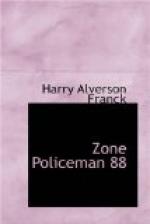The rays of the impetuous Panama sun were spattering from them when I passed again the jumbled rows of invalided locomotives and machinery, reddish with rust and bound, like Gulliver, by green jungle strands and tropical creepers. By day the arch-roofed labor-camps were silent and empty, but for a lonely janitor languidly mopping a floor. Before the buildings a black gang was dipping the canvas and gas-pipe bunks one by one into a great kettle of scalding water. But there are also “married quarters” at Cunette. A row of six government houses tops the ridge, with six families in each house, and—no, I dare not risk nomination to an ever expanding though unpopular club by stating how many in a family. I will venture merely to assert that when noon-time came I was not well started on the second house, yet carried away more than sixty filled-out cards.
More than two days that single row of houses endured, varied by nights spent with “the boss” in the labor-camps of Lirio, Culebra way. Then one morning I tramped far out the highway to the old Scotchman’s farm-house that bounds Empire on the north and began the long intricate journey through the private-owned town itself. It was like attending a congress of the nations, a museum exhibition of all the shapes and hues in which the human vegetable grows. Tenements and wobbly-kneed shanties swarming with exhibits monopolized the landscape; strange the room that did not yield up at least a man and woman and three or four children. Day after blazing day I sat on rickety chairs, wash-tubs, ironing-boards, veranda railings, climbing creaking stairways, now and again descending a treacherous one in unintentional haste and ungraceful posture, burrowing into blind but inhabited cubby-holes, hunting out squatters’ nests of tin cans and dry-goods boxes hidden away behind the legitimate buildings, shouting questions into dilapidated ear-drums, delving into the past of every human being who fell in my way. West Indian negroes easily kept the lead of all other nationalities combined; negroes blacker than the obsidian cutlery of the Aztecs, blonde negroes with yellow hair and blue eyes whose race was betrayed only by eyelids and the dead whiteness of skin, and whom one could not set down as such after enrolling swarthy Spaniards as “white” without a smile.
They lived chiefly in windowless, six-by-eight rooms, always a cheap, dirty calico curtain dividing the three-foot parlor in front from the five-foot bedroom behind, the former cluttered with a van-load of useless junk, dirty blankets, decrepit furniture, glittering gewgaws, a black baby squirming naked in a basket of rags with an Episcopal prayerbook under its pillow—relic of the old demon-scaring superstitions of Voodoo worship. Every inch of the walls was “decorated,” after the artistic temperament of the race, with pages of illustrated magazines or newspapers, half-tones of all things conceivable with no small amount of text in sundry languages, many a page purely of advertising matter, the muscular, imbruted likeness of a certain black champion rarely missing, frequently with a Bible laid reverently beneath it. Outside, before each room, a tin fireplace for cooking precariously bestrided the veranda rail.




